
* In the late 1980s the Soviet government initiated studies on "fifth generation" fighters to replace the current Mikoyan MiG-29 and Sukhoi Su-27. The collapse of the USSR threw such plans into confusion, but development efforts did continue, with the Mikoyan organization flying a "MiG 1.44" fighter demonstrator and the Sukhoi organization flying an "S-37" demonstrator with forward-swept wings. By 2010, the Russian fifth-generation fighter effort had led to the "Sukhoi Su-57", which is to enter service with the Russian Air Force. This document provides a survey of the MiG 1.44, the Sukhoi S-37, and the Sukhoi Su-57. A list of illustration credits is included at the end.
* In 1986, the Soviet government initiated a "Multirole Tactical Fighter (MFI in its Russian acronym)" program to counter Western efforts to develop next-generation fighters, such as the US "Advanced Tactical Fighter (ATF)", which would become the Lockheed Martin F-22 Raptor. Ironically, it was Western fears that the Soviets were working on a fifth-generation fighter that drove the ATF program -- self-fulfilling prophecies were involved.
The Mikoyan experimental design bureau (OKB in its Russian acronym) set up an MFI design team to meet the requirement, originally led by Grigoriy Sedov and later by Yuri Vorontnikov. Early aerodynamic tests were carried out with radio-controlled glider models, each weighing about half a tonne (1,100 pounds), that were dropped from helicopters. Initial MFI prototype construction began in 1989, with the prototype finally rolled out in early 1994. It performed taxi trials later that year, but the program then bogged down to a halt, to remain in darkness for the next several years. Rumors circulated in the West about the secret "MiG 1.42", along with speculations about its features. However, work on the MFI was only dormant, not dead, and the demonstrator, designated the "MiG 1.44", was finally unveiled to the world in January 1999. The MiG 1.42 code was actually for the projected follow-on production version.
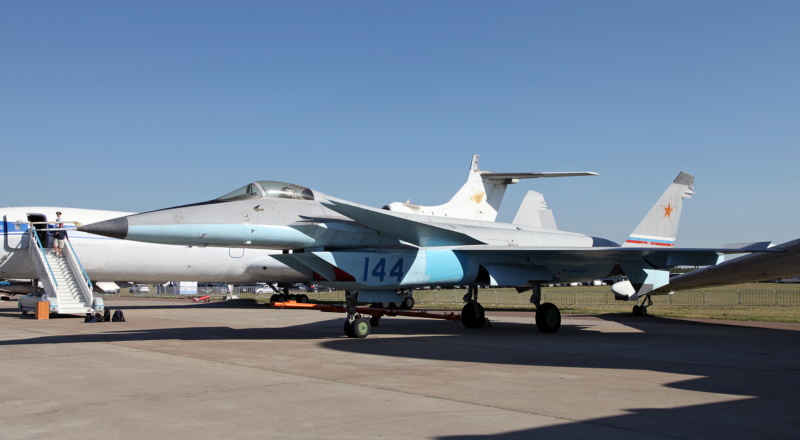
The MiG 1.44 was based on aerodynamic concepts devised at the Soviet Central Aerodynamics & Hydrodynamics Research Institute (TsAGI in its Russian acronym). It looked something like the offspring of the Mikoyan MiG-29 and the Eurofighter Typhoon, the European contribution to the fifth-generation fighter exercise. The MiG 1.44 shared the Typhoon's canard layout, an unusual configuration by Russian standards, and the twin belly engine intakes, but it was clearly not a Eurofighter copy.
___________________________________________________________________
MIKOYAN MIG 1.44 (ESTIMATED SPECS):
___________________________________________________________________
wingspan:
15 meters (49 feet 2 inches)
length:
19 meters (62 feet 4 inches)
height:
4.5 meters (14 feet 9 inches)
empty weight:
18,000 kilograms (39,700 pounds)
normal loaded weight:
28,000 kilograms (61,750 pounds)
max take-off weight:
35,000 kilograms (77,200 pounds)
max speed at altitude:
Mach 2+
service ceiling:
20,000 meters (65,600 feet)
range:
4,000 kilometers (2,500 MI / 2,150 NMI)
___________________________________________________________________
The wings were of cropped delta configuration, with a 45-degree sweep. They had full-span leading edge flaps, and big two-section elevons in the rear. The large canards were placed behind the canopy, and had a dogtooth leading edge. Unlike the Eurofighter and like the MiG-29, the MiG 1.44 had twin tailfins with a slight outward cant. There were fixed ventral fins under tail, matching the tailfins.
The MiG 1.44's lines reflected some degree of "stealth" design, and a production version was to be coated with "radar absorbing material (RAM)" to improve stealth. The aircraft was powered by twin NPO Saturn (previously Lyulka) "AL-41F" low bypass fan jet engines with an afterburning thrust of 175 kN (17,840 kgp / 39,340 lbf) each. The engines gave the MiG 1.44 a "supersonic cruise" capability, and had thrust-vectoring nozzles as well.
The MiG 1.44 had twin-wheel nose gear that retracted backward, while the single-wheel main gear retracted forward. The demonstrator lacked most combat avionics systems, though it did feature an advanced fly-by-wire (FBW) control system, and was fitted with a GSh-301 30-millimeter cannon. In the production version, stores were to be carried in a weapons bay in the center fuselage, though the demonstrator didn't have this feature. Munitions could also be carried on external stores pylons.
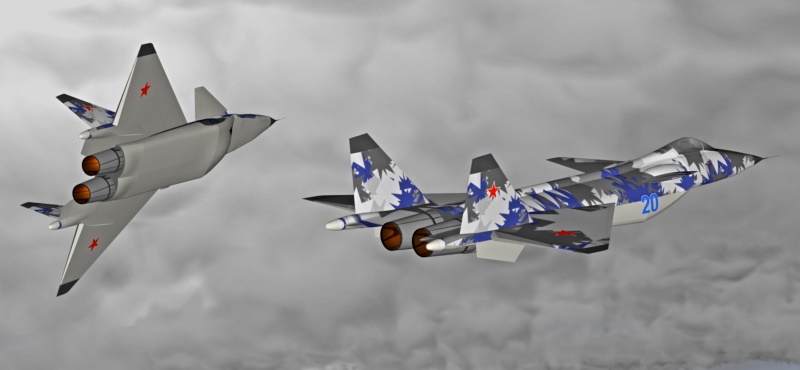
The MiG 1.44 performed its initial flight on 29 February 2000, with test pilot Vladimir Gorbunov at the controls. It flew one more test flight, and then the program was canceled, with the demonstrator being mothballed. The MiG OKB had considered a two-seat version, as well as a "lightweight fighter" designated the "MiG 4.12" that had much the same configuration as the MiG 1.44 but was smaller, with a single engine. That seemed to be an end to the matter for over a decade.
BACK_TO_TOP* During the 1980s, the Sukhoi OKB explored possible follow-ons to the organization's successful Su-27 "Flanker" heavy fighter. From late in the decade work focused on the "Su-37", a strike fighter with canard foreplanes and cranked-arrow delta wing, with a single engine and intakes under the wing roots. It would carry a heavy warload on underwing pylons, though it would also have adequate performance to take care of itself in air-to-air combat. There was considerable interest in the Su-37, but due to the collapse of the Soviet Union, the program never went anywhere. The Su-37 designation was reused later for an Su-27 derivative.
In parallel with work on the Su-37, the Sukhoi OKB investigated a next-generation air-superiority fighter, focusing on a "forward swept wing (FSW)" design originally designated the "S-22". The FSW configuration was known to provide advantages in aerodynamic efficiency, handling, and maneuverability; it had never seen much use, however, because it imposed too much on the wings, meaning they would have to be heavily reinforced, raising weight and eliminating the advantage of the scheme. The availability of composite materials suggested to Sukhoi engineers that it had finally become practical to build an FSW fighter.
Although the Soviet government decided to focus on the Mikoyan OKB's fifth-generation fighter effort, which would lead to the MiG 1.44, the Sukhoi OKB was allowed to continue investigations in parallel. The S-22 design had proved unworkable, and in the absence of a requirement was a nonstarter anyway, so Sukhoi engineers went on to a derivative FSW naval fighter, the "S-32". With the collapse of the USSR, the S-32 program became uncertain; the Sukhoi OKB decided to focus on a relatively simple demonstrator, the "S-37", based on the S-32, and see where things went from there.
As it emerged, the S-37 was about the same size as the Su-27, and leveraged off Su-27 assemblies including the forward fuselage, landing gear, and tailfins. The S-37 of course differed substantially from the Su-27 with the forward-swept wings, which featured a leading-edge sweep of 20 degrees. The wing had a one-piece flap inboard and an aileron outboard on the trailing edge of each wing, plus a leading-edge slat. The S-37 also had all-moving canard foreplanes ahead of the wings. The tail arrangement featured all-moving tailplanes, and twin tailfins with rudders.
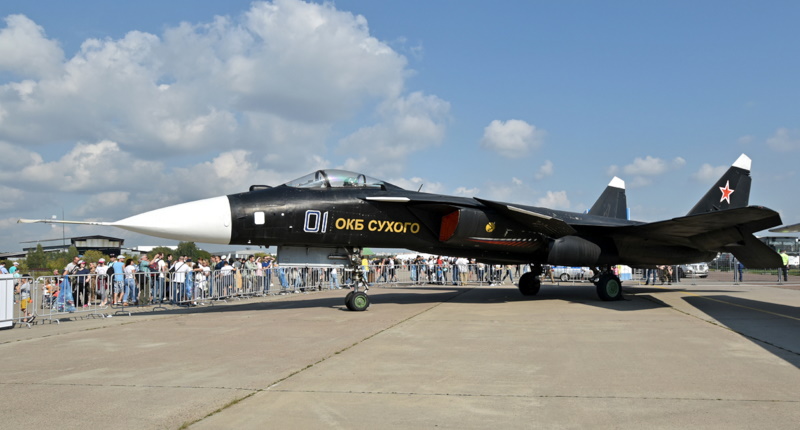
The S-37 was to be powered at the outset by two Soloviev "D30F-11" afterburning low bypass fan jets -- derived from the "D30F-6" engines used on the Mikoyan MiG-31 interceptor, and providing kN (15,600 kgp / 34,390 kgp) each -- to move up to more powerful AL-41F engines with thrust-vectoring exhausts when they became available. The engines were fed by semicircular engine intakes along the sides of the forward fuselage. The demonstrator would not be fitted with full combat kit and would be unarmed, though it did have a weapons bay in the belly. The S-37 was an inherently unstable aircraft that was kept in controlled flight using a fly-by-wire system. The Berkut was so large that its wings folded to allow it to fit into Russian hangars.
___________________________________________________________________
SUKHOI S-37 BERKUT:
___________________________________________________________________
wingspan:
16.7 meters (54 feet 9 inches)
wing area:
61.87 sq_meters (666 sq_feet)
length:
22.6 meters (74 feet 2 inches)
height:
6.3 meters (20 feet 8 inches)
empty weight:
16,375 kilograms (36,100 pounds)
normal loaded weight:
25,000 kilograms (55,115 pounds)
max take-off weight:
35,000 kilograms (77,160 pounds)
max speed at altitude:
Mach 2+
service ceiling:
18,000 meters (59,050 feet)
range:
3,300 kilometers (2,050 MI / 1,780 NMI)
___________________________________________________________________
Two prototypes were ordered, though only one was built. The "Berkut (Golden Eagle)", as it was nicknamed, performed its initial flight on 25 September 1999, with test pilot Igor Votintsev at the controls. It put on a display for the public at the Moscow MAKS airshow in August.
Although the Sukhoi organization promoted a production "Su-47" version of the S-37, the Berkut never went beyond the demonstration phase. It did put in appearances at the MAKS airshow in 2001, 2003, and 2005; by that time, interest had moved on to what would become the Sukhoi Su-57, discussed later, with the S-37 used for tests of Su-57 subsystems.
* While the Sukhoi OKB was working on the S-22 and then the S-32 FSW fighters in the 1980s, the organization also performed design studies for a smaller, single-engine FSW fighter along the lines of the S-37. Not much is known about it, the only released information being photos of wind-tunnel test models, and it doesn't appear to have gone very far.
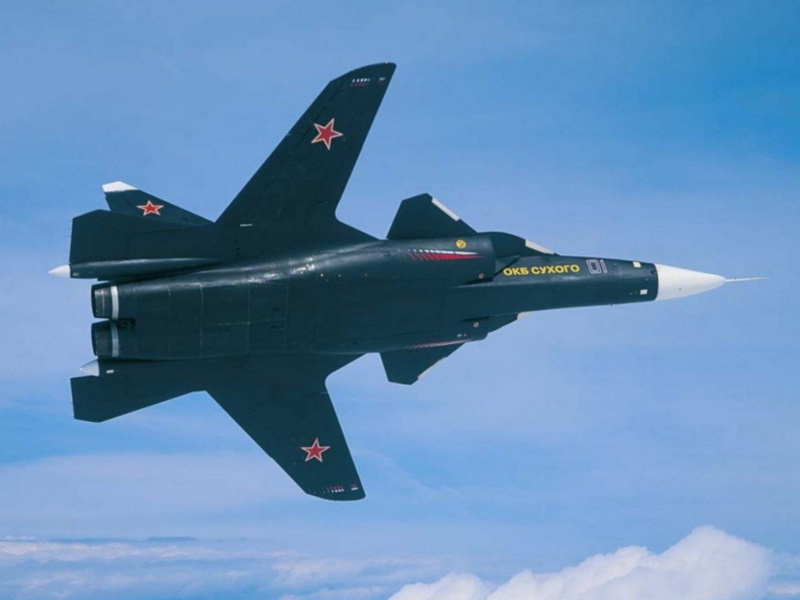
However, the Sukhoi OKB was much more earnest about a series of more conventional designs for a single-engine fighter, the "S-54", with a complementary "S-56" carrier-based variant. The tale is a bit confusing because the S-54 designation was also used for earlier designs of an advanced trainer, but as the S-54 emerged, it looked very much like an advanced derivative of the Su-27 such as the Su-30, with the same general arrangement featuring canard foreplanes.
The S-54 differed substantially in having about half the empty weight and a single engine -- initially an AL-31F, later an AL-41F -- with a wedge-style inlet on the belly. The S-56 was similar to the S-54 but added carrier kit and folding wings -- double folding wings, to give an absolutely minimal footprint on a carrier. The rationale behind the S-54/56 was to offer a cheaper fighter for users who couldn't afford the Su-27. There was fair interest in the concept, but nobody wanted to fund it, and it went nowhere.
BACK_TO_TOP* The Sukhoi organization's work on a fifth-generation fighter didn't stop with the S-37. In 2001, the Russian government announced a fifth-generation fighter effort under the "Future Air Complex for Frontal Air Forces (PAK-FA in its Russian acronym)" program, specifying an aircraft that could compete with the emerging US Lockheed Martin F-35 Joint Strike Fighter, for introduction to service from 2010. A group of Russian industries led by Sukhoi, and another group led by the Mikoyan and Yakovlev organizations, competed for the PAK-FA contract; in late April 2002, the Russian government announced that the Sukhoi group had won the award for its "T-50" design.
Although there were repeated delays in getting the T-50 off the ground, the aircraft's maiden flight finally took place on 29 January 2010, with test pilot Sergey Bogdan at the controls. The T-50 was publicly unveiled at the Moscow MAKS airshow in that year, 2011. It would eventually be given the service designation of "Su-57" -- that designation being preferred here for convenience -- and the NATO reporting name of "Felon".
To no surprise the Russians weren't entirely forthcoming with details about the Su-57, but some information was released, and more could be obtained from videos of the aircraft -- the Russians were generous in showing off the machine to the public and there was no lack of good imagery. It was a large single-seat twin-engine aircraft, looking something a hybrid of the Su-27 and the US F-22 Raptor, less stealthy but said to be more agile than the F-22.
The Su-57 had mid-mounted trapezoidal wings with prominent "leading-edge root extensions (LERX)", along with trapezoidal tailplanes and twin tailfins. Each engine was in a nacelle under the wingroots, straddling the fuselage, with a prominent "stinger" between them in the rear, presumably for defensive systems. Composites were used extensively on the Su-57, making up a quarter of its weight, and titanium were used extensively as well.
The engines were originally NPO Saturn "AL-41F1A" low bypass fan jets. Each AL-41F1A provided 86.3 kN (8,800 kgp / 19,400 lbf) dry thrust and 142 kN (14,500 kgp / 32,000 lbf) afterburning thrust. They were fed through rectangular, raked inlets and had independent vectorable exhausts. They featured full authority digital engine controls (FADEC), and supported non-afterburning supersonic cruise. Operational machines were to be powered by an improved derivative, the "Type 30", with initial flight of an Su-57 with the production engines in 2017.
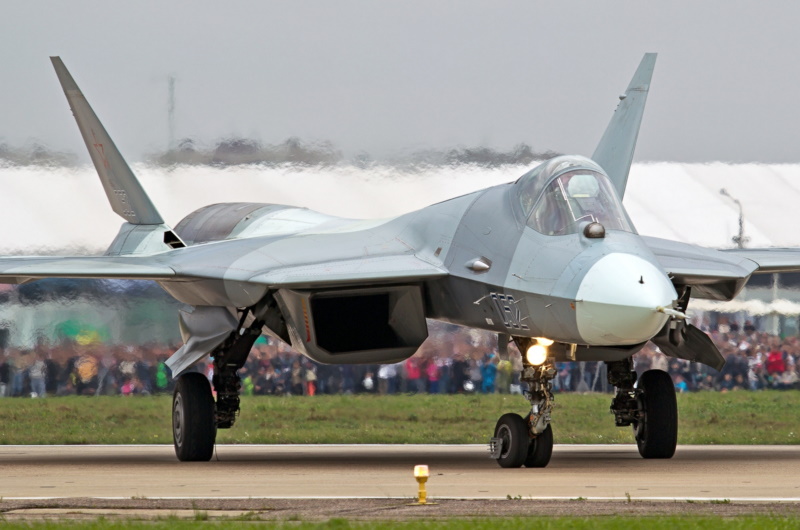
The wings featured trailing-edge ailerons and one-piece flaps; there was a drooping leading-edge flap on the leading edge of the wing, both for take-offs and combat maneuvering; and a drooping control surface at the front of each LERX as well, referred to as a "leading edge vortex controller (LEVCON)". The tailplanes and the tailfins were of "all-moving" configuration. The Su-57 had tricycle landing gear, with twin-wheel nose gear and single-wheel main gear retracting into the sides of the engine nacelles; all gear retracted forward. The Su-57 could deploy twin cruciform brake chutes out of a pop-up hatch on top of the tail stinger.
The pilot sat under a back-sliding canopy on a Zvezda zero-zero ejection seat, using a "glass cockpit" instrument panel with a head-up display (HUD). The Su-57 was built around advanced avionics, including:
Early prototype configurations lacked most operational avionics, kit being methodically upgraded through the course of the trials process.
___________________________________________________________________
SUKHOI SU-57 (ESTIMATED SPECS):
___________________________________________________________________
wingspan:
14 meters (46 feet 7 inches)
wing area:
78.8 sq_meters (848.1 sq_feet)
length:
19.8 meters (71 feet 2 inches)
height:
6.05 meters (19 feet 10 inches)
empty weight:
18,500 kilograms (40,785 pounds)
normal loaded weight:
26,000 kilograms (57,320 pounds)
maximum take-off weight:
37,000 kilograms (81,570 pounds)
max speed at altitude:
Mach 2+
service ceiling:
20,000 meters (65,600 feet)
ferry range:
5,500 kilometers (3,415 MI / 2,970 NMI)
___________________________________________________________________
The Su-57 had twin tandem weapons bays in the "tunnel" between the engine nacelles, each about 5 meters (16 feet) long; there was also a "stealthy" fairing, presumably for weapons carriage, under each wing just outboard of the engine nacelles. There were two hardpoints under each wing for external stores, for a total of four; it appears that a store could also be attached under each engine nacelle. Reported maximum stores load was 7,500 kilograms (16,530 pounds), though obviously only a fraction of that could be carried internally. Possible weapons fits included
Other munitions, such as antiship missiles, could be carried on the underwing pylons. It is difficult to find pictures of the Su-57 showing external stores; presumably it could haul external tanks, but configurations were not revealed. It did have a pop-out inflight refueling probe on the left side of the nose. The Su-57 had built-in armament, in the form of a single 30-millimeter cannon firing out the side of the fuselage to the right and below the cockpit -- though the cannon wasn't fitted in early prototype evaluation.
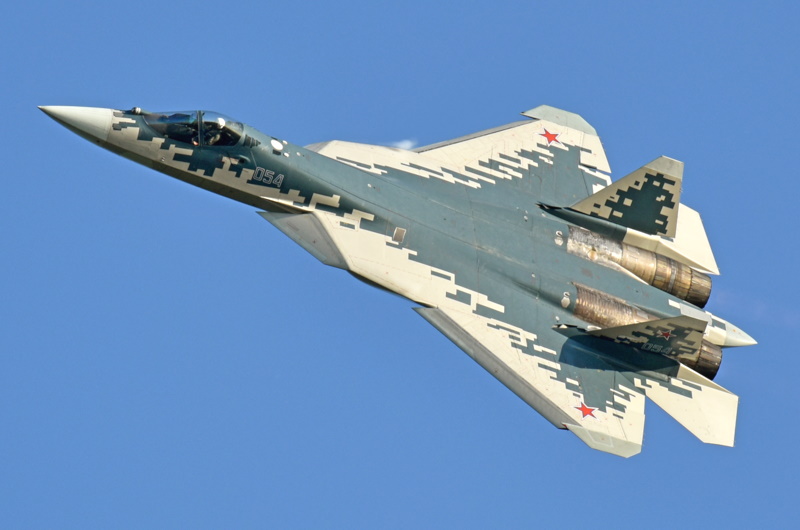
Eight prototypes were produced up to mid-2017, the initial two lacking most operational kit. In early 2018, two Su-57s were sent to Syria for a brief operational evaluation. The Su-57 was also the basis for India's "Fifth Generation Fighter Aircraft (FGFA)", with tweaks to the design to Indian requirements; it was to have two seats and presumably with some local content. Preliminary design of the FGFA was completed in early 2015 -- but India pulled out of the program in 2018, with the Su-57 program becoming uncertain.
In May 2019, Russian President Vladimir Putin announced that the Russian Aerospace Forces -- VKS, as the VVS became in 2015 -- would obtain 76 Su-57s. A total of seven were known to have been delivered in 2021 and 2022. 2022, of course, was the year of Putin's disastrous invasion of Ukraine, throwing not only the future of the VKS, but of all Russia, into doubt. The Russians claim that the Su-57 saw limited combat service in Ukraine, and also play up foreign sales, notably to India; but what actually happens depends heavily on the outcome of the war.
* There was talk of development of a single-engine lightweight fighter to complement the Su-57 -- which ultimately emerged as the "Sukhoi Su-75 Checkmate", which was displayed at the Moscow MAKS-21 airshow in July 2021.
The aircraft's name indicated that it is intended to compete with the US Lockheed Martin F-35. The Checkmate was a stealthy, delta-wing light tactical fighter. Although most modern Russian jet fighters had twin engines, the Su-79 differed in having a single vectored-thrust engine -- presumably a Saturn Izdeliye 30 or some other Saturn AL-41F engine derivative. The fighter had twin canted tailfins; a built-in cannon; an internal weapons bay for five AAMs; an advanced passive detection system and electronic warfare system; an active-array radar; and an auxiliary power turbine.
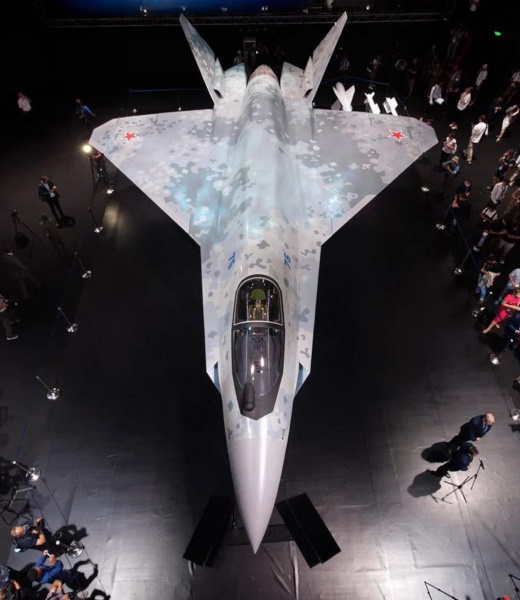
The Su-75 could in principle fly at sustained supersonic speeds of Mach 1.8 (2,150 KPH / 1,335 MPH / 1,160 KT), and had a range of over 2,800 kilometers (1,740 miles / 1,515 NMI). It featured a "glass cockpit" with an artificial intelligence flight assistant, and built-in diagnostic system. Drone, two-seat, and carrier-based variants were in consideration. Being intended as an export system, full development was contingent on finding a buyer. No prototype has flown to this time and, considering circumstances, it's hard to say when one ever will.
There was also talk of an attack drone derived from the Su-57 -- which emerged in 2019 as the Sukhoi "S-70 Okhotnik-B (Hunter-B)". It looked nothing like the Su-57, being a typical flying-wing type drone, with the airframe being derived from the earlier MiG "Skat" attack drone program, though it likely borrowed Su-57 technology. It remains invisible.
BACK_TO_TOP* Sources include:
The online Wikipedia was consulted as well.
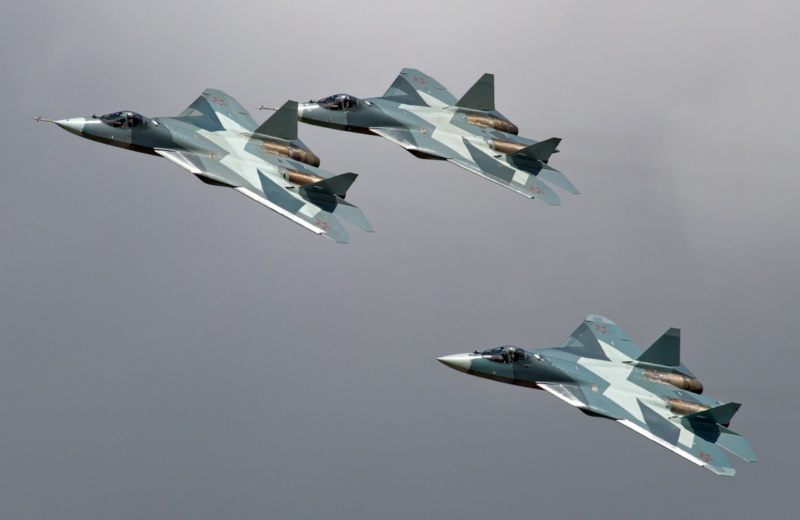
* Illustrations credits:
* Revision history:
v1.0.0 / 01 mar 14 v1.0.1 / 01 feb 16 / Review, update, & polish. v1.0.2 / 01 jan 18 / Review, update, & polish; add Su-57 designation. v1.0.3 / 01 dec 19 / Review, update, & polish. v1.0.4 / 01 dec 21 / Illustrations update. v1.0.5 / 01 oct 23 / Review, update, & polish. v1.0.6 / 01 oct 25 / Review, update, & polish. (!)BACK_TO_TOP
